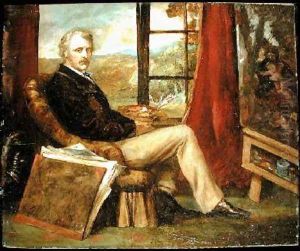Sir Coutts Lindsay Paintings
Sir Coutts Lindsay, 2nd Baronet, was a British artist, engraver, and notable figure in the Victorian art world, born on October 2, 1824, in Muncaster, England. Coming from a privileged background, Lindsay was well-positioned to pursue his interests in the arts from a young age. He was educated at Eton and Trinity College, Cambridge, before embarking on his artistic training. Despite his aristocratic roots, Lindsay was deeply committed to the advancement of contemporary art and sought to challenge the conventional tastes and practices of the art establishments of his time.
In 1877, Sir Coutts Lindsay co-founded the Grosvenor Gallery in London with his wife, Blanche, who was also an artist and the daughter of the Pre-Raphaelite painter James McNeill Whistler's patron, Frederick Richards Leyland. The Grosvenor Gallery quickly became a focal point for the aesthetic movement, showcasing works by artists who were either ignored or rejected by the Royal Academy, including James McNeill Whistler, Edward Burne-Jones, and other Pre-Raphaelites. The gallery was renowned for its opulent interior and innovative approach to exhibition presentation, which was a stark contrast to the more traditional venues of the time. It played a crucial role in promoting the careers of many artists associated with the aesthetic movement and in broadening the public’s appreciation for modern art.
Lindsay's own artistic output was varied, though less well-known than his contributions as a patron and gallery owner. He worked in a range of media, including painting and engraving, and his style was influenced by the Pre-Raphaelites and the broader aesthetic movement. Despite the eventual financial difficulties and the closure of the Grosvenor Gallery in 1890, Lindsay's efforts had a lasting impact on the London art scene and the promotion of aestheticism in art.
After the gallery's closure, Lindsay continued to paint and be involved in artistic communities, though his influence waned in his later years. Sir Coutts Lindsay died on May 7, 1913, leaving behind a legacy as a pioneer in the promotion of modern art in Victorian Britain. His contributions helped to pave the way for future generations of artists and laid the groundwork for the diverse and inclusive approach to art exhibition seen in galleries and museums today.
